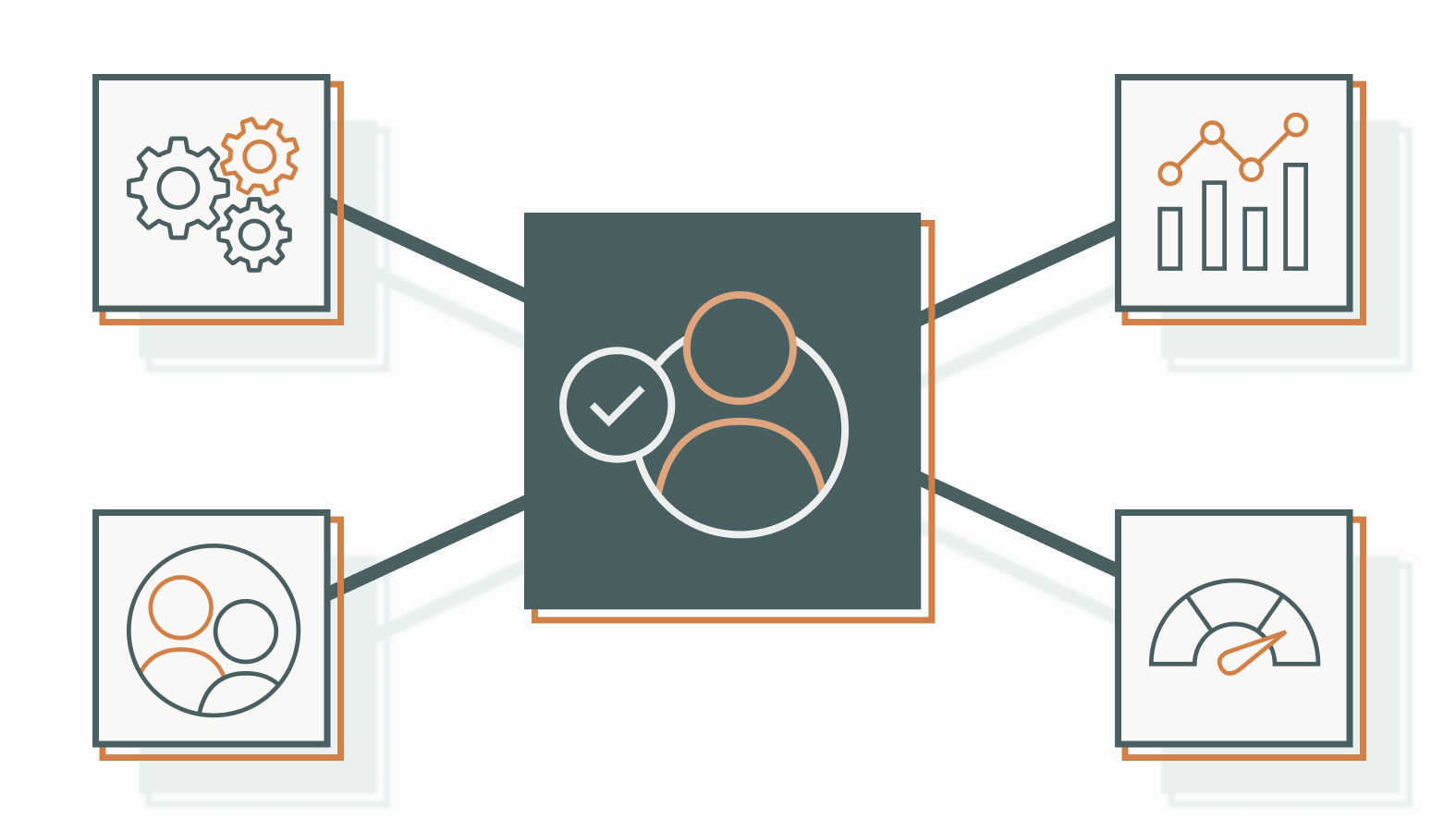Trying to run account-based marketing without the right platform is like trying to race a Formula 1 car on bald tires; you won’t get far, and you’ll waste a lot of fuel in the process. As B2B buying cycles grow more complex and sales teams chase ever-tighter pipelines, companies need more innovative tools that deliver on the promise of ABM.
That’s the gap that account-based marketing platforms are meant to bridge. Built to help teams stay aligned, focused, and strategic, these platforms give marketers the insights and execution power to take a strategy and successfully turn it into real business results, specifically generating qualified leads and moving them through the sales pipeline.
But with so many options (and big promises), it’s easy to overpay for something that doesn’t quite fit or underestimate what your business really needs.
In this guide, we’ll walk through the top ABM platforms of 2025, break down their standout features, compare pricing, and show you what to look for before making a call.
What is an Account-Based Marketing Platform?
Account-based marketing (ABM) focuses your efforts where they count: on high-value accounts with the highest revenue potential. Instead of generating broad, low-conversion leads, ABM aligns marketing and sales around a shared goal: engaging and converting your most strategic targets.
ABM platforms operationalize that strategy. These platforms help you identify the right accounts, personalize outreach across channels, and orchestrate campaigns that align with sales cycles, not just marketing calendars.
With the right ABM platform, your team can:
- Prioritize accounts based on firmographics, intent, and engagement data.
- Automate tailored messaging and experiences at scale.
- Coordinate efforts across sales and marketing teams in real-time.
- Measure account-level performance and pipeline impact with precision.
This precision leads to fewer wasted resources, higher close rates, and stronger long-term client relationships. In a complex B2B environment where buying committees rule, and sales cycles stretch, ABM platforms give you the infrastructure to execute with focus and agility. They help you stay coordinated, efficient, and insight-driven.
When the right tech powers your ABM strategy, revenue growth becomes repeatable, and account loyalty becomes measurable.
Must-Have Features in Modern Account-Based Marketing Platforms
When you’re targeting high-value accounts, you need tools that can orchestrate personalization at scale, keep your revenue teams aligned, and deliver results with less waste. The right ABM platform does all of that and more.
However, not all account-based marketing platforms are built equally. Here’s what to look for in an ABM solution built for today’s speed and tomorrow’s scale.
Seamless Integration Capabilities
An ABM platform that doesn’t integrate well is just another silo. You need interoperability with the platforms your teams already live in: CRMs like Salesforce or HubSpot and automation systems like Marketo or Pardot.
The essentials:
- Robust API access to ensure data flows freely between systems, enabling seamless information exchange
- Two-way sync with CRM and MAP tools to maintain a unified view of account activity and streamline cross-functional workflows
- Fast implementation timelines that minimize disruption and accelerate time to value without months of IT overhead
- Out-of-the-box compatibility with major software solutions so your ABM platform works with what you’ve already invested in
These integrations reduce manual work, prevent data discrepancies, and enable account-level personalization across every touchpoint—sales, marketing, and customer success.
Don’t consider integration as just another feature. Think of it as the foundation of scalable, effective ABM.
Advanced Analytics and Reporting Tools
Data without context is noise. A modern ABM platform needs to do more than count impressions. It should track engagement by account, surface buying signals, and tie marketing performance to revenue.
Look for:
- Real-time analytics to adjust campaigns on the fly and make confident, data-backed decisions
- Custom dashboards for different stakeholders. For example, CMOs need different insights from SDRs.
- Predictive analytics to identify warm accounts before they even raise their hand
- ROI-focused reporting that connects marketing efforts to pipeline impact and closed revenue
The right platform should both collect data and transform it into actionable insights. From campaign performance to account-level engagement, advanced analytics let you refine strategy, optimize spend, and stay ahead of the curve.
Reliable Customer Support Services
Even the best platforms need support. Whether you’re troubleshooting a sync issue or navigating a new feature rollout, having access to experienced, responsive support can save you hours (or days) of lost momentum.
Prioritize platforms that offer:
- Dedicated account managers who understand your business model and provide personalized, strategic guidance
- Comprehensive onboarding and ongoing training resources to keep your team sharp and self-sufficient
- Fast, reliable technical assistance to resolve issues quickly and prevent disruption
Strong support is a multiplier. The right resources help your team fully leverage the platform’s capabilities, adapt faster, and continuously improve your ABM strategy.
Ensuring High Data Quality
ABM lives or dies by data accuracy. Bad data means missed opportunities, irrelevant messaging, and a bloated pipeline full of ghosts. Your data must be clean, complete, and current to target the right accounts with the right message at the right time.
Key features to look for:
- Automated data cleansing and enrichment tools that eliminate duplicates, fix errors, and fill in gaps
- Ongoing data validation integrations to verify and update information as it changes
- Regular audit capabilities so your ops teams can spot and correct issues before they snowball
- Support for data integrity workflows to ensure consistency across systems and campaigns
Accurate data drives precision, performance, and pipeline velocity. Without it, ABM doesn’t work.
Leading Account-Based Marketing Platforms in 2025 and Beyond
Account-based marketing keeps getting smarter. The platforms leading the charge combine cutting-edge tech with powerful analytics and smooth user experiences. They do more than manage campaigns—they make precision marketing scalable and agile.
In 2025, the best ABM platforms are those that seamlessly integrate data, automation, and insights to deliver real business impact. Let’s break down the top players setting the standard today.
6sense Revenue AI: Predictive Insights for ABM Growth
6sense Revenue AI is built for marketers who don’t have time to guess. It applies predictive intelligence to cut through noise, identify in-market buyers, and drive revenue with surgical accuracy. Instead of chasing cold leads, your team focuses on accounts that are already showing intent, backed by hard data, not hunches.
This platform isn’t just a data aggregator. It’s an operating system for account-based marketing, sales alignment, and predictable pipeline generation. Using advanced behavioral analytics and intent signals, 6sense maps entire buying journeys before your prospect even fills out a form.
Key Features
Here’s where it pulls ahead: it doesn’t stop at visibility. It activates that intelligence across channels, empowering marketers and sales teams to engage prospects in a personal and timely way.
- AI-Driven Predictions: Uses machine learning to surface in-market accounts and forecast purchase intent with high accuracy.
- Account-Based Insights: Offers deep, real-time visibility into buyer behavior, keyword intent, decision-stage progression, and anonymous visitor identification.
- Multi-Channel Orchestration: Enables automated, personalized campaigns across email, display ads, website, CRM, and sales outreach—all coordinated from a single platform.
- Sales Intelligence Tools: Equips sales teams with prioritized account lists, contact recommendations, and tailored messaging strategies based on AI-derived insights.
- CRM and MarTech Integrations: Seamlessly connects with platforms like Salesforce, HubSpot, Marketo, and Outreach, making it easy to activate insights across your existing stack.
Pricing and Scalability
6sense offers a tiered pricing structure tailored to company size, use case complexity, and data volume. It’s not a one-size-fits-all model. Pricing typically starts with a custom quote, reflecting the platform’s scalability and focus on enterprise-grade results.
While the investment is significant, the ROI often comes in shorter sales cycles, higher win rates, and cleaner pipeline forecasting.
Demandbase One: Unified ABM, Advertising & Sales Intelligence
Demandbase One is a fully integrated account-based marketing platform designed for B2B organizations that need precision, scale, and clarity across the funnel. It combines marketing, sales, and advertising in one system powered by deep account intelligence.
The platform goes beyond basic targeting. It pulls in firmographic, technographic, and intent data to help teams prioritize the right accounts, deliver hyper-targeted campaigns, and align messaging with where each buyer is in their journey. Everything connects back to a central source of truth, so strategy, execution, and measurement stay in sync.
Key Features
Demandbase One brings together powerful capabilities under one roof:
- Advanced Account Intelligence: Real-time firmographic and intent data help you prioritize accounts that are in-market and ready to buy.
- Targeted Advertising: Create account-based ad campaigns across channels with dynamic audience targeting, suppression, and creative personalization.
- Sales Intelligence: Gives reps visibility into buying signals, engagement history, and predictive scoring to sharpen outreach and boost conversions.
- Orchestration Engine: Automate multi-channel campaigns using account signals and custom triggers to guide prospects through the funnel.
- Connected Data Platform: Unifies first- and third-party data into a single, centralized source so teams operate on consistent, reliable insights.
- Engagement Metrics & Attribution: Visualize account progression, measure pipeline impact, and tie campaigns directly to revenue outcomes.
Pricing
Demandbase One follows a custom pricing model based on your business’s size and complexity. Plans are tailored to align with your ABM maturity, data needs, and team structure. Expect strategic guidance during onboarding and scale-focused support as you grow.
This platform is built for modern go-to-market teams that are ready to align effort with outcome. If you’re aiming to unify marketing and sales around the accounts that matter most, Demandbase One is built for that mission.
ZoomInfo Marketing OS: Data-Driven Lead Generation at Scale
ZoomInfo Marketing OS is built for marketers who move fast and play smart. With access to one of the most extensive databases of B2B contact and company intelligence on the market, this platform gives teams the data muscle they need to execute high-performing campaigns, sharpen their targeting, and accelerate pipeline growth. Especially powerful for ABM and intent-based strategies, it helps marketing and sales stay aligned and effective across the entire funnel.
This platform stands out for its ability to connect rich, real-time data with automation and orchestration tools that scale with your goals. With ZoomInfo Marketing OS, it’s not just about filling the top of the funnel but filling it with the right leads at the right time and activating those insights through your systems of choice.
Key Features
- Extensive B2B Database: Access verified data on over 100 million business contacts and decision-makers across industries and regions.
- Intent and Engagement Signals: Identify accounts showing active buying signals based on real-time web behavior and proprietary intent data.
- Automated Lead Scoring: Prioritize contacts based on behavioral data and fit to focus resources where they’ll generate the most impact.
- Campaign Orchestration Tools: Launch targeted campaigns using contact-level intelligence integrated into workflows and triggers.
- CRM and Marketing Automation Integrations: Seamlessly connects with Salesforce, HubSpot, Marketo, and other leading platforms for clean data sync and streamlined execution.
- Audience Builder: Create hyper-targeted segments using filters like job title, department, technographic data, and buyer intent.
Pricing
ZoomInfo Marketing OS operates on a subscription-based pricing model, with tiers based on data access level, user seats, and feature sets. Plans are tailored to fit company size and scope, with enterprise solutions available for large teams or complex sales environments. Custom quotes are standard, so expect pricing to align with the depth of functionality your go-to-market strategy demands.
HubSpot: All-in-One CRM & ABM Solution for B2B Teams
HubSpot isn’t trying to be a tool in your tech stack—it’s aiming to be the control center. As one of the most comprehensive ABM-ready CRMs available, HubSpot delivers marketing, sales, and customer success features that sync seamlessly for precision-targeted campaigns and high-efficiency growth.
HubSpot is built for B2B teams who want to connect their strategies, data, and outreach under one roof without sacrificing depth or scalability.
This platform doesn’t stop at contact management. HubSpot automates workflows, aligns GTM teams, and personalizes outreach at scale while feeding real-time performance insights back into the system. It’s designed to make your marketing smarter and your sales process tighter, whether you’re nurturing leads or closing enterprise deals.
Key Features
- Native CRM with ABM Tools: Identify high-value accounts, assign target tiers, and view buying committee activity all in one place.
- Automated Workflows: Streamline lead nurturing and internal handoffs between marketing and sales.
- Advanced Personalization: Customize email and website content based on account behavior, firmographics, and lifecycle stage.
- Multi-Touch Attribution: Get complete visibility into which marketing and sales efforts actually drive revenue.
- Real-Time Analytics: Monitor performance of ABM campaigns, pipeline progression, and engagement by account.
- Ad Management Integration: Launch and track targeted LinkedIn, Facebook, and Google campaigns directly from HubSpot.
- Sales Enablement Tools: Equip your reps with account-specific insights, playbooks, and templates.
Pricing
HubSpot offers a tiered pricing model. Free CRM features give startups a reliable entry point while its premium Marketing, Sales, and Service Hubs scale up to enterprise-grade capabilities.
Pricing is modular, so you can invest based on business maturity and team needs. Keep in mind that serious ABM requires unlocking the Professional or Enterprise tiers.
For B2B teams ready to centralize and scale their go-to-market strategy, HubSpot brings the infrastructure and the intelligence to make it happen.
How to Choose the Best ABM Platform for Your Business
ABM is a precision B2B marketing machine that requires the right engine to drive results. The right ABM platform allows your team to align marketing and sales around high-value accounts, personalize outreach at scale, and track performance across the entire funnel.
Here’s how to select the right platform for your business without getting lost in vendor noise.
1) Define Your Goals and Target Outcomes
Every ABM initiative starts with clarity. What outcomes are you targeting?
- Are you trying to accelerate pipeline velocity?
- Improve expansion revenue?
- Increase deal size through hyper-personalization?
List your primary and secondary goals, then map them to platform capabilities. This will quickly narrow your options and avoid overbuying features you won’t use.
For example, if your top priority is multi-channel personalization, rule out tools that are weak on intent data or dynamic content delivery.
Get strategic first, then tactical.
2) Compare Key ABM Features That Matter Most
Not all ABM tools are created equal. Look for features that support core workflows:
- Account selection and targeting: How well can the platform identify in-market accounts using firmographic, technographic, and intent data?
- Orchestration: Can it automate sequences across channels like ads, email, web, and sales outreach?
- Personalization at scale: How granular can you go with messaging? Can you customize content for individual stakeholders?
- Attribution and reporting: Can it track influence across the buyer journey, not just the last touch?
Test usability, too. A feature-packed platform is useless if it’s clunky. Your team needs to act on insights, not spend weeks in training.
3) Prioritize Integration and Platform Scalability
ABM doesn’t work in a silo. Your platform should integrate with your team’s existing systems, such as CRM, MAP, data warehouses, and sales enablement tools.
Strong integration ensures clean data flow between systems, unified reporting, and less manual work for your team. Without it, you’re stuck juggling exports and patching tech gaps with workarounds.
Also, think long-term. Will the platform still serve you as your ABM strategy matures? Look for tools that can scale with advanced use cases, such as AI-powered predictive analytics, multi-region campaigns, or deeper customer lifecycle engagement.
4) Understand Pricing and Calculate Potential ROI
ABM platforms range from mid-tier tools to enterprise suites with price tags to match. Get clear on:
- License or seat-based pricing
- Add-ons (like data enrichment or predictive modules)
- Usage caps (e.g., number of target accounts or campaigns)
Compare potential costs against the lift in revenue or savings from automation. ROI isn’t theoretical—look at your current funnel metrics. If a platform helps shorten sales cycles or reduce customer acquisition costs, that’s tangible value. Map expected gains to platform costs and build your business case from there.
5) Learn from Real Users and Industry Peers
Demos are fine, but user experience is where platforms either thrive or crash.
Scan reviews from marketers with similar use cases. Look for recurring feedback on things like support responsiveness, feature reliability, and learning curve.
Better yet, connect with peers in your network. Ask what they love, what frustrates them, and what they’d do differently if they were choosing again.
Don’t just buy the logo; buy the outcomes.
Equip Your Marketing Strategy with the Right ABM Tools
A strong ABM platform is more than feature-rich—it drives real results. It aligns sales and marketing, supports your go-to-market strategy, and delivers a measurable impact on pipeline velocity and revenue growth.
Choosing the right solution means looking beyond surface comparisons. Start by defining your goals, evaluating each option strategically, and investing in a platform that grows with your ambitions.
ABM’s success thrives on precision, not guesswork. The right platform streamlines execution, enables personalized outreach at scale, and powers smarter decisions throughout the buying journey.
Ready for a fresh perspective on your current tools? Or need expert help finding and implementing the perfect ABM solution? Schedule a candid conversation with one of our experts and make your next move with confidence.








